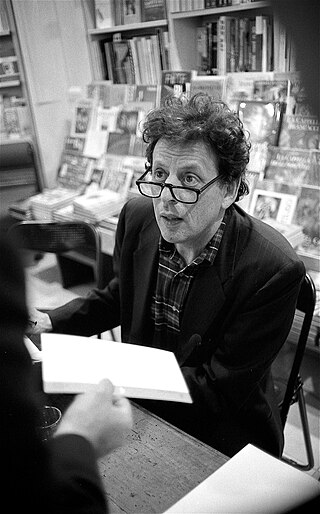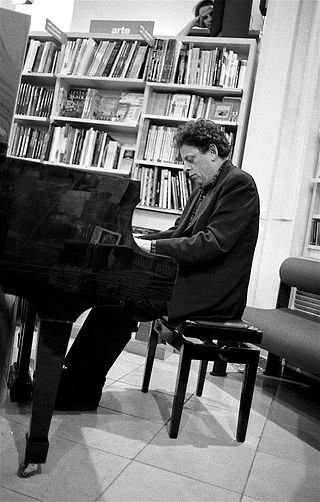
Philip Glass is an American composer and pianist. He is widely regarded as one of the most influential composers of the late 20th century. Glass's work has been associated with minimalism, being built up from repetitive phrases and shifting layers. Glass describes himself as a composer of "music with repetitive structures", which he has helped to evolve stylistically.
A concerto is, from the late Baroque era, mostly understood as an instrumental composition, written for one or more soloists accompanied by an orchestra or other ensemble. The typical three-movement structure, a slow movement preceded and followed by fast movements, became a standard from the early 18th century.

The Brandenburg Concertos by Johann Sebastian Bach are a collection of six instrumental works presented by Bach to Christian Ludwig, Margrave of Brandenburg-Schwedt, in 1721. The original French title is Six Concerts Avec plusieurs instruments, meaning "Six Concertos for several instruments". Some of the pieces feature several solo instruments in combination. They are widely regarded as some of the greatest orchestral compositions of the Baroque era.
A harpsichord concerto is a piece of music for an orchestra with the harpsichord in a solo role. Sometimes these works are played on the modern piano. For a period in the late 18th century, Joseph Haydn and Thomas Arne wrote concertos that could be played interchangeably on harpsichord, fortepiano, and pipe organ.
A solo concerto is a musical form which features a single solo instrument with the melody line, accompanied by an orchestra. Traditionally, there are three movements in a solo concerto, consisting of a fast section, a slow and lyrical section, and then another fast section. However, there are many examples of concertos that do not conform to this plan.

The keyboard concertos, BWV 1052–1065, are concertos for harpsichord, strings and continuo by Johann Sebastian Bach. There are seven complete concertos for a single harpsichord, three concertos for two harpsichords, two concertos for three harpsichords, and one concerto for four harpsichords. Two other concertos include solo harpsichord parts: the concerto BWV 1044, which has solo parts for harpsichord, violin and flute, and Brandenburg Concerto No. 5 in D major, with the same scoring. In addition, there is a nine-bar concerto fragment for harpsichord which adds an oboe to the strings and continuo.
A triple concerto is a concerto with three soloists. Such concertos have been composed from the Baroque period, including works by Corelli, Vivaldi, Bach and Telemann, to the 21st century, such as two works by Dmitri Smirnov. The most famous example is Beethoven's Triple Concerto for violin, cello and piano. His combination of solo instruments, a piano trio, was often used also in later works.
Karl Aage Rasmussen is a Danish composer and writer.
A double concerto is a concerto featuring two performers—as opposed to the usual single performer, in the solo role. The two performers' instruments may be of the same type, as in Bach's Double Violin Concerto, or different, as in Brahms's Concerto for Violin, Cello and Orchestra.

The Cello Concerto No. 1 was written by Philip Glass in 2001. It was one of the first concerti of the twenty-first century. The piece was commissioned by William and Rebecca Krueger, friends of both the cellist Julian Lloyd Webber and the conductor Yu Long in celebration of Lloyd Webber's 50th birthday and the first anniversary of Maestro Yu's China Philharmonic Orchestra. The work was premiered by Lloyd Webber with Long Yu conducting the China Philharmonic during the 2001 Beijing Music Festival, and attracted significant attention as the first time the work of a major western composer had its world premier in China. A typical performance takes about 30 minutes. The work is paired with the Concerto Fantasy for Two Timpanists and Orchestra as part of Glass' Concerto Project, a series of collected concerti by the composer. The cello concerto is among the most famous of Glass' works for a solo instrument.

The Concerto Project is a collection of concerti written by Philip Glass. The series was begun in 2000 and contains eight works, the most famous of which is probably the Concerto for Cello and Orchestra. Some of the concerti in the volumes were written before the commencement of the project and were categorized into the series.
The Concerto Fantasy for Two Timpanists and Orchestra is a double timpani concerto written by Philip Glass in 2000. It is paired with the Cello Concerto on Vol. I of Glass' Concerto Project, a set of eight concerti by the composer. A typical performance of the work lasts 25–28 minutes. It was written for Jonathan Haas and later recorded by Evelyn Glennie, and was premiered by Haas and Svet Stoyanov with the American Symphony Orchestra in Avery Fisher Hall, Lincoln Center, conducted by Leon Botstein. The work was commissioned jointly by the American Symphony Orchestra, the Peabody Symphony, the Milwaukee Symphony, the St. Louis Symphony and the Phoenix Symphony. In 2004, a transcription for wind ensemble was written by Mark Lortz, which debuted at Peabody Institute in 2005.

The Piano Concerto No. 2 was written by American composer Philip Glass in 2004. It is also called the Piano Concerto No. 2: After Lewis and Clark, due to its musical representation of the American pioneers. It was composed for the Nebraska Lewis and Clark Bicentennial Commission, the Lied Center for Performing Arts, and the University of Nebraska-Lincoln Hixson–Lied College of Fine and Performing Arts. It is included as one of the concerti in Glass' Concerto Project, a four-volume collection of commissioned works. The work itself deals with the journey of Meriwether Lewis and William Clark, interpreting the stages of their expedition progressively in each movement.
The Concerto Grosso No. 1 was the first of six concerti grossi by Soviet composer Alfred Schnittke. It was written in 1976–1977 at the request of Gidon Kremer and Tatiana Grindenko who were also the violin soloists at its premiere on 21 March 1977 in Leningrad together with Yuri Smirnov on keyboard instruments and the Leningrad Chamber Orchestra under Eri Klas. It is one of the best-known of Schnittke's polystylistic compositions and marked his break-through in the West.

Johann Sebastian Bach wrote his fifth Brandenburg Concerto, BWV 1050.2, for harpsichord, flute and violin as soloists, and an orchestral accompaniment consisting of strings and continuo. An early version of the concerto, BWV 1050.1, originated in the late 1710s. On 24 March 1721 Bach dedicated the final form of the concerto to Margrave Christian Ludwig of Brandenburg.
The Harpsichord Concerto in A major, BWV 1055, is a concerto for harpsichord and string orchestra by Johann Sebastian Bach. It is the fourth keyboard concerto in Bach's autograph score of c. 1738.
Alfred Schnittke composed his Concerto Grosso No. 3 for two violins, harpsichord, piano, and celesta in 1985.





